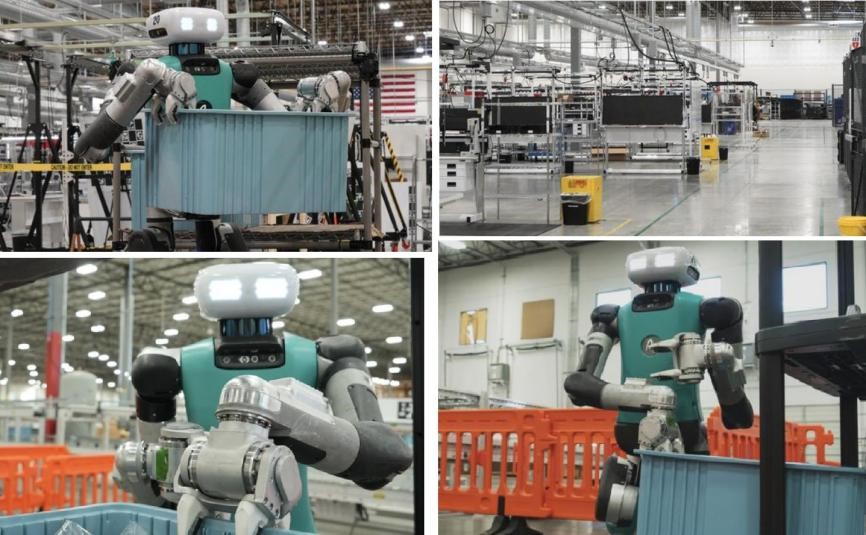With the rapid development of science and technology, humanoid robots are gradually entering our world, and it seems that they are about to usher in their own golden area. The commissioning of Agility Robotics' RoboFab plant marks a major milestone in the humanoid robotics industry. The factory is the "world's first humanoid robot gigafactory", located in Salem, Oregon, United States, with a planned annual production capacity of 10,000 humanoid robot Digit, demonstrating the great potential of humanoid robots in the field of automation.
1. Technological innovation and production capacity
Agility Robotics' Digit robots are highly innovative in design. It is approximately 175 cm tall, with stainless steel actuators on its shoulders and hips, and its head and torso are covered with circuits and sensors, reminiscent of the human nervous system. Not only does this design make the Digit look close to human, but more importantly, it is capable of working in large warehouse environments, utilizing a unique back knee design to lift and lower items.
The production line of the RoboFab factory is equipped with workstations dedicated to assembling the robot's arms, legs, torso and head, as well as areas for testing Digit's cameras and lidars. The factory's "robot hospital" is used to deal with the problems reported by customers during actual use and to maintain them. This efficient production model, combined with the Robotics-as-a-Service (RaaS) program, allows Agility Robotics to respond quickly to market demands.

Pictured: Humanoid robots at work in Agility Robotics' RoboFab factory
2. Market outlook and investment trends
According to PitchBook, startups in the field of humanoid robotics have attracted about $1.6 billion in venture capital over the past five years. Agility Robotics has raised a total of $180 million to support its large-scale manufacturing strategy to address the growing demand for automation in the warehousing and logistics industry. With the maturity of technology and the reduction of costs, the market potential for humanoid robots is huge, and it is expected to achieve rapid growth in the next few years.
For example, Norway robotics startup 1X Technologies closed a $100 million funding round earlier this year, with OpenAI also participating. These investments not only reflect the confidence of the capital market in the humanoid robot industry, but also demonstrate the rapid development momentum of the industry.
3. Social impact and ethical considerations
The wide application of humanoid robots will have a profound impact on society. On the one hand, they can undertake highly repetitive and dangerous work, improve production efficiency, and reduce the burden of human labor. On the other hand, the popularity of humanoid robots has also sparked discussions about employment, ethics, and privacy. For example, questions such as whether humanoid robots are likely to replace human jobs, whether they are able to adhere to ethical norms when performing tasks, and how to ensure that their use does not infringe on personal privacy.
With the popularity of humanoid robots, so has society's concern about their ethical issues. When humanoid robots mimic human behavior and emotions, they may blur the boundaries between humans and machines, leading to controversy over identity and privacy protection. Therefore, the establishment of a comprehensive ethical framework to guide the design, production and application of humanoid robots is a necessary condition to ensure the healthy development of the humanoid robot industry.
4. Future outlook
The commissioning of Agility Robotics' RoboFab factory is not only an important development in the humanoid robotics industry, but also a microcosm of the development of artificial intelligence and robotics. With the continuous advancement of technology and the expansion of the market, humanoid robots will show their unique value in more fields. In the future, humanoid robots will likely play a key role in medical care, education, services and other fields, and become an indispensable partner in human life and work.
According to research data, the global humanoid robot market is expected to grow at a CAGR of 17% over the next five years. This trend is not only a technological achievement, but also a change in society's perception of human-computer interaction. Humanoid robots will become assistants in our lives, not substitutes, and all sectors of society should also maintain rational thinking in this regard, and promote the synchronization of technological development and ethics.
Summary
The launch of Agility Robotics' Digit robot and its RoboFab factory marks the rise of the humanoid robotics industry. With the continuous progress of technology and the growth of market demand, humanoid robots will play an increasingly important role in production and life in the future. In the face of challenges and opportunities, the industry needs to constantly adapt to changes and find new growth points through technological innovation and market strategy adjustment. Humanoid robots are not only the progress of science and technology, but also the transformation of human lifestyles in the future.






